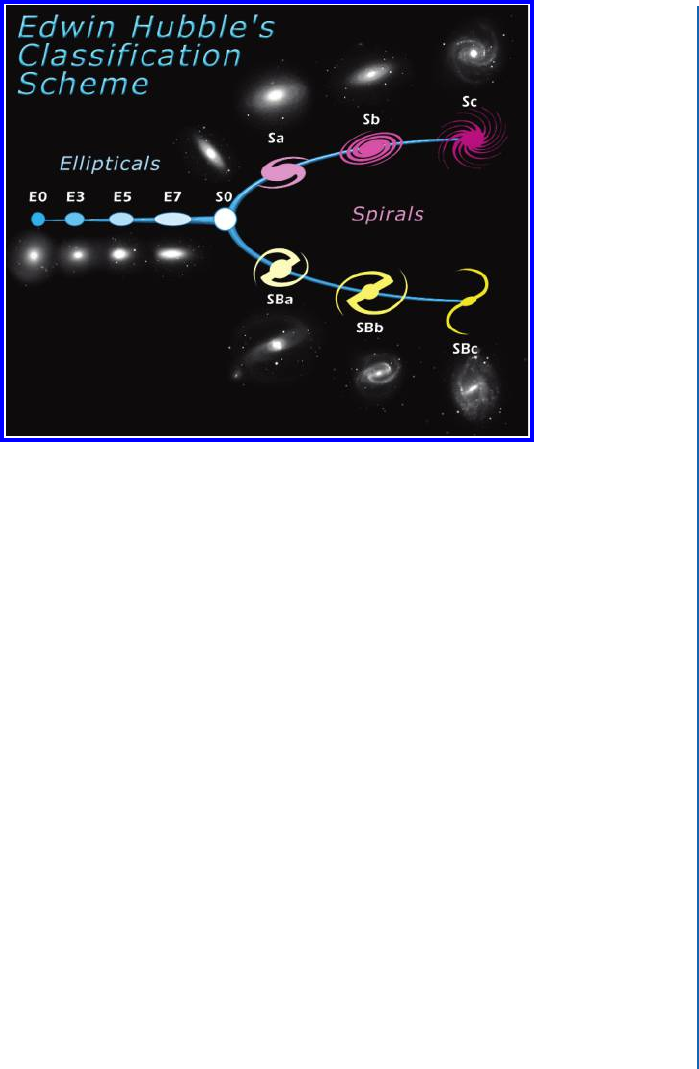
16.3. THE HUBBLE TUNING-FORK DIAGRAM 229
Figure 16.3: e Hubble tuning fork diagram for the classification of galaxy types. (Graphic
credit NASA and ESA, CC BY-SA 4.0.)
16.3 THE HUBBLE TUNING-FORK DIAGRAM
e Hubble classification scheme can be arranged into a natural progression of galaxy types,
from E0–E7, and then splitting into two branches—one each for unbarred and for barred spirals.
Type S0 marks the branching point between ellipticals and spirals in this tuning fork diagram;
see Figure 16.3.
e spirals seem to make a progression from large bulge with tightly wound spiral arms
(Sa) to very small and indistinct bulge with loose, open spiral arms (Sc). ose with a bar fea-
ture are labeled, for example, SBb instead of Sb. Taking inspiration from the more-complex
de Vaucouleurs classification described in Section 16.4, the Hubble galaxy types are sometimes
extended to Sd (or SBd), and irregular galaxies are placed at the ends of the fork.
16.4 THE DE VAUCOULEURS CLASSIFICATION SCHEME
In 1959 Gerard de Vaucouleurs proposed a far more elaborate classification system that accounts
for greater variations in the appearance of galaxies. In particular, the de Vaucouleurs classifica-
tion scheme allows for types intermediate between “normal” and barred spirals. And the system
allows for the appearance of ring-like structures in spiral galaxies. Figure 16.4 shows some ex-
amples.

230 16. THE STRUCTURE OF GALAXIES
Figure 16.4: Top left: NGC 3031, type SA(s)ab. Top center: NGC 1097, type SB(s)b. Top
right: NGC 1433, type SB(r)a. Bottom left: NGC 1232, type SAB(rs)c. Bottom center: NGC
1313, type SB(s)d. Bottom right: the same galaxy as bottom center, but imaged in the near
infrared instead of blue light. (Images made with the Aladin sky atlas. DSS2; Bonnarel et al.
[2000], Lasker et al. [1996].)
e de Vaucouleurs classification uses SA to represent unbarred spirals and SB to denote
barred spirals. Intermediate forms—those galaxies with evidence of only a weak bar feature—are
labeled SAB. e lowercase letters a, b, and c are used as in the Hubble classification, but a type
d is added for galaxies that have essentially no trace of a bulge, but still betray a hint of spiral
structure. ese d-type spirals are nearly irregular, and so they form a natural morphological
bridge between spirals and irregulars. Forms intermediate between, for example, type b and
type c, are denoted “bc.” us, there are really seven possible types: a, ab, b, bc, c, cd, and d.
And finally, the de Vaucouleurs scheme identifies another morphological feature that is
absent from the Hubble classification—the presence of a ring-like feature in the disk. As such,
the de Vaucouleurs distinguishes between “ring-shaped” and “s-shaped” galaxies, using the let-
ters (r) and (s), in parentheses, to denote the distinction. A galaxy that seems intermediate be-
tween the two forms is labeled with (rs).
And so a full de Vaucouleurs classification could be, for example, SA(rs)c—which means
an unbarred spiral with a small bulge and loose spiral arms that seems to have a hint of a ring.
..................Content has been hidden....................
You can't read the all page of ebook, please click here login for view all page.
